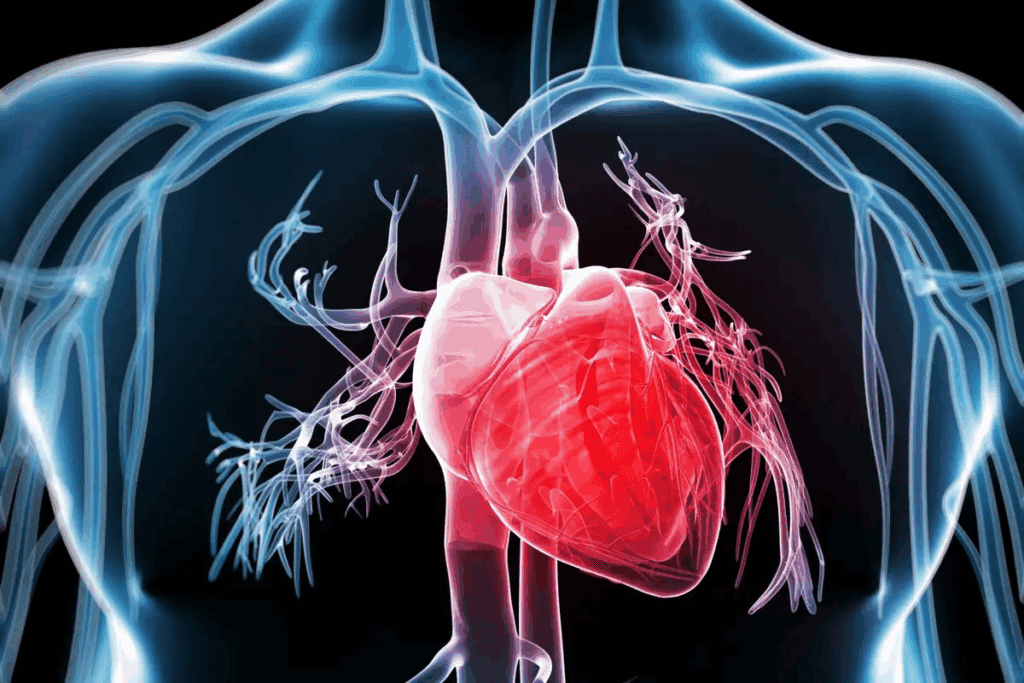Last Updated on November 25, 2025 by Ugurkan Demir

It’s important to know the difference between heart disease and congenital heart disease. This knowledge helps patients and families get the right care and prevent problems.
Learn heart disease vs congenital heart disease differences in causes and signs.
Congenital heart disease means the heart has problems from birth. Medical Expert, a pediatric cardiologist at Medical organization, explains this.
On the other hand, heart disease usually comes from years of factors. Knowing the difference is key for good treatment.

To understand heart disease and congenital heart disease, we need to start with the basics. The cardiovascular system is a complex network of organs and vessels. It works together to circulate blood throughout the body.
The cardiovascular system, also known as the circulatory system, includes the heart, blood vessels, and blood. It’s vital for delivering oxygen and nutrients to cells and organs. It also removes waste products. The heart is a muscular organ that pumps blood through the blood vessels. It supplies the body with the necessary oxygen and nutrients. Knowing how this system works is key to understanding heart conditions.
Distinguishing between different heart conditions is vital for proper diagnosis and treatment. Heart disease and congenital heart disease are two distinct conditions. They require different management and care approaches. By understanding these differences, healthcare providers can develop targeted treatment plans. These plans address the specific needs of each patient. This improves patient outcomes and enhances the quality of life for those affected by heart conditions.
Understanding heart conditions also helps in preventing and early detecting complications. Recognizing risk factors and symptoms of heart disease and congenital heart disease is important. Individuals can take proactive steps to mitigate their risk. They can also seek medical attention when necessary.

Heart disease covers many conditions that affect the heart. It’s a big problem worldwide, causing a lot of sickness and death. It also puts a big strain on healthcare and the economy.
Acquired heart disease happens over time. It’s caused by genetics, lifestyle, and environment. Coronary artery disease is the most common. It happens when arteries get narrow or blocked by plaque.
Other types include heart failure and arrhythmias. Heart failure means the heart can’t pump enough blood. Arrhythmias are abnormal heart rhythms.
Many things can increase your risk of heart disease. These include aging, smoking, high blood pressure, high cholesterol, diabetes, and obesity. A diet full of saturated fats and not enough exercise also raises risk.
The Medical organization says heart disease is a big problem. It affects millions globally. Knowing the risks is key to preventing and managing it.
Managing heart disease needs a full plan. This includes changing your lifestyle and sometimes medical help. By understanding heart disease, you can help keep your heart healthy.
Congenital heart disease is a complex condition present at birth. It involves heart problems that affect not just the person but their family too. It requires a deep understanding and care.
Congenital heart disease means heart problems that are there from birth. These can be in the heart’s walls, valves, or blood vessels. It often comes from genetics and environmental factors during pregnancy.
Genetic factors are a big part of it, with some conditions passed down. But, environmental influences like the mother’s health also play a role. These can affect how the heart develops in the womb.
Congenital heart disease is a common birth defect. It affects nearly 1% of births, or about 40,000 babies, each year in the United States. This shows how important it is to catch it early.
The numbers show we need more research and better care before and after birth. Knowing the facts helps us support families better and aim for better results.
Understanding congenital heart disease is key for healthcare and families. Knowing its definition, causes, and how common it is helps us give the right care and support.
Congenital heart defects are problems in the heart that babies are born with. They affect how blood moves through the heart and the body. These issues happen early in fetal development, when the heart is forming.
A congenital heart defect means the heart or its main blood vessels didn’t form right. This makes the heart work harder, which can lead to problems. The severity of these defects can vary widely, from mild to severe.
“Congenital heart defects are among the most common types of birth defects, affecting nearly 1 in 100 births worldwide.”
Congenital heart defects can involve different problems, like issues with the heart’s walls, valves, and blood vessels. Some common types include:
| Type of Defect | Description | Common Symptoms |
| Atrial Septal Defect (ASD) | A hole in the wall between the heart’s upper chambers | Shortness of breath, fatigue |
| Ventricular Septal Defect (VSD) | A hole in the wall between the heart’s lower chambers | Poor feeding, failure to thrive |
| Tetralogy of Fallot | A combination of four heart defects, including VSD and pulmonary stenosis | Cyanosis, clubbing of fingers |
Knowing about these defects is key to helping those affected. Early diagnosis and treatment can greatly improve their lives.
Heart disease and congenital heart disease have different causes and stages of development. Heart disease develops over time, influenced by lifestyle and genetics. Congenital heart disease, on the other hand, is present at birth due to heart development issues during fetal formation.
Congenital heart disease happens during fetal development, often due to genetic or environmental factors. Heart disease, by contrast, develops later in life due to risk factors like high blood pressure and smoking.
Medical Expert, a cardiologist, explains, “The timing of these conditions is key. Congenital heart disease needs early treatment, often right after birth. Heart disease, though, can be managed with lifestyle changes and medication over years.”
The causes of heart disease and congenital heart disease are different. Heart disease is linked to lifestyle choices and conditions like hypertension. Congenital heart disease, though, is often caused by genetics or environmental factors during pregnancy.
“Understanding these conditions’ causes is vital for prevention and treatment,” says Medical Expert, a leading researcher in cardiovascular diseases.
Key differences in causes include:
Healthcare providers can better meet patients’ needs by understanding these differences. This improves outcomes and quality of life for both conditions.
Knowing when heart disease and congenital heart disease start is key. The time when these conditions appear can change how they are treated and managed.
We’ll look at how heart disease is linked to aging. Congenital heart disease, though, is something people are born with.
Heart disease, or cardiovascular disease (CVD), is more common in older adults. Factors like high blood pressure and smoking build up over time. This leads to heart disease later in life.
The Centers for Disease Control and Prevention (CDC) says heart disease gets more common with age. It affects a lot of people over 65.
“The risk of heart disease increases with age, and it is more common among older adults.” – CDC
Congenital heart disease (CHD) is present at birth. It happens when the heart or blood vessels don’t form right during fetal development.
These heart defects can be simple or complex. The American Heart Association says congenital heart defects are the most common birth defect. They affect nearly 1 in 100 babies.
| Condition | Typical Age of Onset | Causes/Risk Factors |
| Heart Disease | Older adults (65+ years) | High blood pressure, high cholesterol, smoking, aging |
| Congenital Heart Disease | Present at birth | Genetic factors, environmental factors during fetal development |
The age when heart disease and congenital heart disease start shows they are different. Heart disease comes from aging and lifestyle. Congenital heart disease, on the other hand, is a birth defect that needs early care.
Heart disease and congenital heart disease have different challenges. They deal with structural versus functional issues. Knowing these differences is key for the right diagnosis and treatment.
Congenital heart disease (CHD) often has anatomical abnormalities from birth. These structural problems can affect the heart’s chambers, valves, or major blood vessels. This can lead to issues with blood flow and oxygenation.
These anatomical abnormalities need precise diagnosis. They often require surgery to fix the structural issues.
Heart disease, on the other hand, involves functional deterioration over time. This can come from lifestyle, aging, and other health conditions. It can lead to heart failure or arrhythmias.
Functional issues in heart disease may show up as:
While heart disease can have some structural changes, like ventricular remodeling, the main challenge is the functional decline.
The difference between structural and functional issues is critical in understanding heart conditions. This distinction greatly affects how we diagnose, treat, and manage heart disease and congenital heart disease.
It’s key to know the different risk factors and causes of heart disease and congenital heart disease. This knowledge helps in making better prevention and treatment plans. We will dive into the unique risk factors and causes of each condition.
Heart disease is linked to lifestyle choices. Poor diet, lack of exercise, smoking, and too much alcohol are major risk factors. These habits can lead to high blood pressure, high cholesterol, and diabetes, all of which harm the heart.
Eating too much saturated fat, sodium, and sugar raises heart disease risk. Being inactive can lead to obesity and other heart risks. Changing these habits can lower heart disease risk.
Congenital heart disease is mainly caused by genetics and development. Genetic mutations, chromosomal issues, and environmental factors during fetal development play a big role. Unlike heart disease, lifestyle choices have a smaller impact on congenital heart disease.
Some genetic conditions, like Down syndrome, increase CHD risk. Maternal diabetes and certain pregnancy medications also raise the risk. Knowing these factors helps in better prevention and treatment.
Understanding these differences helps healthcare providers create better prevention and treatment plans for both heart disease and congenital heart disease.
It’s key to know the symptoms of heart disease and congenital heart disease for the right diagnosis and treatment. Both conditions impact the heart but show different signs and symptoms.
Heart disease, linked to aging and lifestyle, shows up with shortness of breath, chest pain (angina), and fatigue. These signs come from the heart’s gradual decline, often due to blocked arteries or high blood pressure.
As heart disease gets worse, swelling in the legs, ankles, and feet can happen. This is called edema. In the most severe cases, heart failure can occur, causing severe shortness of breath and making everyday tasks hard.
“The symptoms of heart disease can be subtle at first, but they gradually worsen over time, stressing the need for early detection and management.”
Congenital heart disease, present at birth, shows different symptoms that can be spotted early. Common signs include cyanosis (a bluish skin color), rapid breathing, and poor feeding in infants. Some defects might not be found until later in childhood or adulthood, depending on how severe they are.
| Symptom | Heart Disease | Congenital Heart Disease |
| Shortness of Breath | Common, often due to heart failure | Present, specially in severe defects |
| Cyanosis | Rare, unless in advanced heart failure | Common in certain defects, like Tetralogy of Fallot |
| Fatigue | Frequent, due to reduced heart function | Variable, depending on the defect’s severity |
The differences in symptoms between heart disease and congenital heart disease show the need for specific diagnostic and treatment plans. Knowing these differences helps healthcare providers give better care, leading to better patient outcomes.
It’s key to know how doctors diagnose heart disease and congenital heart disease. The way they test for these conditions shows their unique nature.
Doctors use many tests to check the heart’s health. Echocardiograms create heart images with sound waves. Electrocardiograms (ECGs) measure the heart’s electrical signals. Stress tests see how the heart handles physical activity.
Blood tests also play a role. They check for heart risk factors and damage. For example, lipid profiles show cholesterol levels, and troponin signals heart muscle damage.
Congenital heart disease (CHD) can be found before birth with fetal echocardiography. This ultrasound looks at the fetal heart. After birth, pulse oximetry screening checks oxygen levels in the blood.
More tests like echocardiograms and ECGs are used after birth. They help confirm CHD and see how severe it is. Sometimes, cardiac MRI or CT scans are needed for a detailed look.
Finding CHD early is vital for better care and outcomes. Knowing how to diagnose both heart disease and CHD helps doctors give the right treatment.
The terms ‘congenital heart disease’ and ‘congestive heart failure’ are often mixed up. But they are two different heart problems. Congenital heart disease is about heart issues you’re born with. Congestive heart failure is when your heart can’t pump enough blood for your body’s needs.
Congestive heart failure (CHF) is a long-term condition where your heart can’t pump blood well. This leads to fluid buildup in your body, like in your legs and lungs. Symptoms include shortness of breath and feeling tired.
CHF can come from many things, like heart disease, high blood pressure, and diabetes. Knowing about CHF is key to managing its symptoms and improving life quality. By treating the root causes and using the right treatments, people with CHF can see big improvements.
Congenital heart defects can raise the risk of heart failure later on. These defects can strain your heart, causing long-term damage. For example, defects like ventricular septal defects or tetralogy of Fallot can lead to heart failure if not managed right.
It’s important to watch and manage congenital heart defects early to avoid or delay heart failure. Thanks to medical progress, people with congenital heart disease can now live active lives well into adulthood.
While both congenital heart disease and congestive heart failure affect the heart, they are different. Congenital heart disease is a birth defect with structural problems. Congestive heart failure, on the other hand, develops over time due to various factors, including congenital heart defects.
Knowing these differences is key for accurate diagnosis and treatment. By clearing up the confusion between these conditions, we can better help patients manage their heart health.
It’s key to know the difference between heart disease and congenital heart disease. This knowledge helps in diagnosing, treating, and managing these conditions. We’ve looked at how they start, their symptoms, and how doctors diagnose them.
Knowing the unique traits of each condition helps people manage their heart health better. It’s important to be aware and manage these conditions well. This awareness and management are vital for better health outcomes.
By focusing on heart health, we can prevent and manage these conditions better. Let’s work together to understand these conditions better. This will lead to better heart health for people all over the world.
Heart disease comes from lifestyle choices or aging. Congenital heart disease is present at birth, with heart problems.
It’s heart problems at birth. These can be structural or functional issues with the heart or its blood vessels.
These are heart structure problems at birth. They can be simple or complex, affecting how the heart works.
Yes, it is. It affects the heart and blood vessels, impacting cardiovascular health.
Congenital heart disease is heart problems at birth. Congestive heart failure is when the heart can’t pump enough blood. It’s a complication of congenital heart disease.
Yes, they can. Diet, exercise, and smoking affect heart disease risk. Genetics play a bigger role in congenital heart disease.
Heart disease is diagnosed with tests like electrocardiograms and angiograms. Congenital heart disease is found prenatally or after birth with echocardiograms.
It’s a heart problem at birth. These can be mild or severe, needing different treatments.
Yes, they are. They are found before or shortly after birth through tests.
CVD is a wide term for heart and blood vessel issues. CHD is heart problems at birth.
National Health Service (NHS). (2025). Heart Disease vs Congenital Heart Disease 7 Key. Retrieved from https://www.nhs.uk/conditions/congenital-heart-disease/types/[3
Subscribe to our e-newsletter to stay informed about the latest innovations in the world of health and exclusive offers!